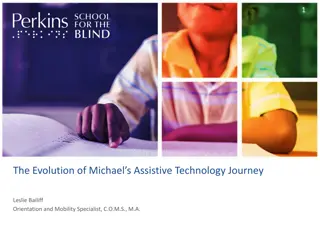
Exploring Dissociative Manifestations Through a Developmental Lens
Delve into the complexities of dissociative manifestations in the context of trauma, abuse, and attachment disruptions, shedding light on the varied causations and impacts on development. Understand the role of adverse childhood experiences in potentiating distress, disruption, and disconnection, ultimately influencing attachment dynamics and skill deficits.
Download Presentation

Please find below an Image/Link to download the presentation.
The content on the website is provided AS IS for your information and personal use only. It may not be sold, licensed, or shared on other websites without obtaining consent from the author. If you encounter any issues during the download, it is possible that the publisher has removed the file from their server.
You are allowed to download the files provided on this website for personal or commercial use, subject to the condition that they are used lawfully. All files are the property of their respective owners.
The content on the website is provided AS IS for your information and personal use only. It may not be sold, licensed, or shared on other websites without obtaining consent from the author.
E N D
Presentation Transcript
Revealing a Broader Terrain of Dissociative Manifestations via a Developmental Perspective Michael A. Qui ones, PhD Steven N. Gold, PhD IndependentPractice, Ft. Lauderdale, Florida
The Importance of Defining Terms Trauma Complex Trauma Developmental Trauma Development Attachment Style Attachment [Capacity] Adversity
Adverse Childhood Experiences ALSO, FOR EXAMPLE: POVERTY COMMUNITY VIOLENCE
ACEs: Varied Causation of Dissociation Trauma Abuse Developmental Deprivation Neglect Disruption Disturbed Attachment Household Dysfunction Skills Distress Heightened Threat Disconnection Deficits in Behavioral and Emotional
ACEs and Dissociation: Distress, Disruption, and Disconnection ACEs potentiate distress, developmental disruption, and experiential disconnection Distress: Physical and sexual abuse (experiencing or witnessing) can incur traumatic stress and developmental stress (stressors that detract from adequate growth and development). Neglect and household dysfunction can incur distress from both deprivation and the presence of psychological and emotional stressors Disruption: ACEs disrupt the provision of beneficial experiences and caregiving necessary for adequate growth and development Disconnection: from traumatic and distress-related dissociation, neglect and deficient interpersonal connection and support
ACEs and Dissociation: Attachment Dynamics, Threat and Deprivation, & Performance and Skills Deficits 1. Attachment Dynamics: Disruptions in the development of secure attachment can range from insufficient attention and responsiveness to a child s basic needs to the more explicit disruptions from exposure to abuse, severe neglect, and chronic household dysfunction ACEs contribute excessive psychological and emotional distress that disrupts the adequate provision of attention and responsiveness needed to develop secure attachment. More severe forms of insecure attachment (i.e., fearful/disorganized) develop due to increased exposure to the developmental and traumatic stressors attributed to ACEs.
ACEs and Dissociation: Threat and Deprivation 2. Experiences of Threat and Deprivation (McLaughlin, Sheridan, & Lambert, 2014) Chronic distress and disruption from ACEs have meaningful impacts related to experiences of persistent threat, deprivation, and disconnection from the necessary supportive relationships and nurturance needed in childhood Experiences of Deprivation i.e., inadequate social, cognitive, emotional stimulation such as neglect, poverty Experiences of Threat i.e., harm or threat of harm such as abuse, exposure to community violence hypersensitivity and over-reactivity to possible danger, e.g. development, e.g. Growing up under these conditions promotes Growing up under these conditions promotes compromised hypersensitivity to potential danger deficits in various components of cognitive functioning a proclivity to rapidly detect anger compromised executive functioning overgeneralization of responses to threat deficits in inhibitory control equivalent fear-based reactivity to threat and safety cues limitations in social cognition
ACEs and Dissociation: Performance and Skills Deficits 3. Performance and Skills Deficits: Performance deficits are restrictions in functioning (i.e., psychological, emotional, behavioral, and interpersonal) that underlie the capacity to carry out functional skills such as cognitive and emotion regulation skills, social skills, and adaptive behaviors. E.g., PTSD symptoms: hyperarousal, hypervigilance, emotional and psychological distress, perpetuate impairments in the ability to function adaptively Skills deficits describe deficits in skill-based capacities necessary for adequate functioning in various domains of life (e.g., interpersonal and social functioning, effective communication, capacity for learning, and developing adaptive skills and behaviors). The relationship between performance and skills deficits is bidirectional. Difficulty developing and utilizing adaptive skills due to performance deficits (i.e. from PTSD symptoms), can lead to chronic experiences of frustration, distress, and ineffectiveness. Resulting in maladaptive behaviors and modes of functioning (e.g. externalizing behaviors, avoidance, isolation, maladaptive coping) that present as skills deficits.
Trauma versus Deprivation
IMPLICATIONS All trauma is adversity, but not all adversity is trauma. Non-trauma adversity may be damaging, but the damage does not take the form of traumatization. Trauma is different from deprivation each has different consequences, and requires different remedies. Trauma can result in traumatization, which interferes with the expression of existing functional capacities (i.e., performance deficits). Deprivation inhibits the acquisition (i.e., existence) of functional capacities (i.e., skills deficits).
Trauma-Related versus Deprivation-Related Dissociation Dissociation literally means, and can generally be usefully thought of, as (psychological) disconnection. Trauma-Related Dissociation (the freeze component of fight-flight- freeze reflex) is a form of protection that interferes with the expression of existing functional capacities. Deprivation-Related Dissociation is the result of an inadequately developed capacities for connection, which can take the form of limited sense of affiliation with/connection to other people ability to sustain attention to what is going on around one awareness of the subjective realm sensations, perceptions, emotions, thoughts, memories
Contributions of Trauma Versus Deprivation to Dissociation Overlap and Distinctions The importance of distinguishing trauma-related dissociation from dissociation consequent to developmental deprivation is in identifying the appropriate therapeutic strategies for each: Interventions aimed at trauma resolution, to remove impediments to the expression of existing functional capacities Interventions designed to transmit capacities that are weak or absent because they were never fully developed due to having been reared in circumstances marked by deprivation (inadequate developmental resources and support).
A Brain-Based Hierarchy of Mental Processes BASE BRAIN Sensation Perception Emotion Cognition Behavioral Interpersonal/Social CORTEX
Neuroscience on C-PTSD (Lanius, Bluhm, & Frewen, 2011; Akiki, Averill, & Abdallah, 2017) Changes in connectivity and functionality related to PTSD Increased connectivity between anterior cingulate cortex (ACC), amygdala, and insula. Associated with: Associated with hyperarousal, threat-detection, motivation, avoidance, and behavioral responses Impaired top-down modulation of emotional distress Decreased connectivity among ventromedial prefrontal cortex, posterior cingulate cortex (PCC), and medial temporal lobe. Associated with: Intrusive symptoms, re-experiencing Heightened fear response and avoidance Dissociative experiences, depersonalization & derealization
Neuroscience on C-PTSD (Lanius, Bluhm, & Frewen, 2011; Akiki, Averill, & Abdallah, 2017) Disturbances in Self Organization Aberrant activity and connectivity within/between neural networks associated with self-concept, emotion regulation, threat detection, and cognition. Alterations in over-and-under emotion modulation via PFC and limbic structures (e.g., amygdala and hippocampus) can result in: Negative self-concept Alterations in reactivity and dissociative reactions can result in impairments to memory encoding and executive functions resulting in discontinuity of self Hyperactive limbic structures and orientation to threat can impair encoding of neutral and positive experiences resulting in negative expectancies towards self and others Affective dysregulation Chronic hyperactivity of limbic structures can potentiate reduced activity and connectivity among the PFC and capacity for modulation of affect. Alterations between states of hyperarousal and dissociation Interpersonal difficulties and disruptions Heightened sensitivity to threat and avoidance can disrupt continuity of interpersonal relationships, potentiate lability in interpersonal relationships
Neuroscience on C-PTSD (Lanius, Bluhm, & Frewen, 2011; Akiki, Averill, & Abdallah, 2017)
Applying the Triple Network Model to the Neurobiology of PTSD Salience network Akiki & colleagues (2017) proposed a Network-based Neurobiological Model of PTSD from a review of findings on the neurobiology of PTSD: dACC, amygdala, insula structural activity and network activity Heightened threat-detection (hyperarousal) Impaired DMN and CEN modulation (aberrant activity with DMN, impaired attention and regulation by CEN) Default mode network Central executive network vmPFC, PCC, MTL dlPFC, precuneus structural activity and network activity Disrupted thought process (intrusive sx s, re-experiencing) Altered sense of self/reality (dissociation) Fear generalization (avoidance symptoms) structural activity and network activity Cognitive deficits, impaired executive functions Loss of top-down SN regulation
Different Sources, Different Interventions Trauma-related performance deficits (interference with existing functional capacities) can effectively be addressed via interventions designed to promote trauma (such as exposure-based and cognitive processing approaches), Deprivation-related skills deficits (absent or weak functional capacities) are not remediable via trauma-focused approaches, but rather require interventions designed to transmit functional capacities (such as the skills training in DBT). There are instances, especially in difficulties related to complex trauma,
Convergent Sources, Divergent Intervention Delivery Especially in complex trauma, there are difficulties that are a consequence of both trauma and developmental deprivation, for example Chronically elevated distress Complex trauma-related: pervasive, chronic hyperarousal Deprivation-related: deficient capacity for self-soothing Problems with interpersonal trust Complex trauma-related hypervigilance/ hypo vigilance Deprivation-related: lack of adequately reliable criteria for trust In these instance there are interventions that will address both sources of the difficulty, but there will be nuanced differences in the way they are delivered to address each of these two sources.
Forms of Dissociation Related to Developmental Deficits
Incomplete Bi-Lateral Integration A relative lack of bilateral integration, manifested by: difficulty coordinating movement between the right and left sides of the body, with the experience of the right and left sides of the body as markedly more distinct, separate, and independent than is commonly the case. a sense of separateness, likely to be accompanied by a functional and experiential weakness of sensory integration and physical coordination between the right and left sides of the body an unsteady gait and general difficulty maintaining balance.
Poor Visual Coordination A relative lack of coordination between right and left eyes: A visual manifestion of the lack of bilateral integration vision experienced as two rather than three dimensional due to a lack of muscular coordination between the right and left eyes as a consequence, the external world is perceived as flat and lacking depth unlike compromised motor functioning, this mode of experience may not be recognized as anomalous by the person experiencing it because it never occurred to them that there is an alternative
Lack of a Sense of Corporeal Depth and Dimension The visceral experience of oneself as two dimension(i.e., flat) as opposed to three dimensional: a lack of a stable sense of one s body as having depth and dimension. It is as if the visual sense of flatness is analogously how one s physical being is experienced.
Alexithymia Alexithymia, a substantial defi cit in emotional awareness that is associated with difficulty identifying the presence of emotion, the relative absence of intensely felt affect, considerable difficulty differentiating emotions from each other, and limitations in the ability to verbalize emotions has been found to be related to dissociation. The dissociative lack of ability to discern the presence of emotions, distinguish shades of emotion, and express them is a function of attentive, responsive parenting, and therefore likely to be appreciably adversely affected in emotionally unresponsive families. Ozsoy and Ta c (2021) found alexithymia, dissociation, and a history of emotional abuse and neglect to be elevated in patients with chronic migraine headaches. It is not unusual for dissociative clients to report anotable degree of poor awareness of affect or its intensity, even when their overt behavior appears strikingly emotionally reactive.
Deficient Emotional Object Constancy The absence of a stable sense of emotional object constancy, which reflects the experience that another person still exists and continues to be a source of care even when they are not physically present. Emotional object constancy is highlighted in Margaret Mahler s separation- individuation theory ( Blum, 2020 ; Mahler, Pine, & Bergman, 1975 ), a good example of the correspondence between attachment and other facets of development. Insecurity surrounding emotional object constancy finds expression in comments indicating uncertainty about whether the therapist is still there between sessions or when out of town, and a general insecurity about the clinician s degree of caring and reliability. It is a very good example of one facet of the lack of attainment of secure attachment that extends beyond attachment styles. It is one indicator of a relative inability to experience interpersonal connection, so that when another person is not physically present, there is no sense of relationship to them.
Interpersonal Emotional Disconnection The relative absence of the ability to feel connected to other people (i.e., the capacity for experiencing emotional intimacy). Distinct from deficient emotional object constancy, it is more the absence of a sense of interpersonal connectedness than the inability to retain an implicit and confident sense that others exist and continue to care about oneself. As with the other phenomena that we view as being more closely attributable to deficient development than to the impact of trauma, the sense of distance from others is not seen as a form of defense (i.e., insecure attachment) but rather as a weak or missing capacity. We propose that when one grows up around people who are not caring and attentive, the receptors for these experiences are not firmly established. Facilitating this attainment through consistent, clearly discernable attentiveness and responsiveness is a central function of the therapist in treating survivors with complex dissociation.
Relative Absence of a Sense of Corporality A persistent and pervasive sense of self as disembodied: often a corresponding experience of seeing things from a vantage point outside one s body rather than through one s eyes, Essentially chronic depersonalization. In this respect, among the phenomena described here it comes closest to a widely recognized variant of dissociation. What distinguishes it from depersonalization as it is commonly construed is that it has been a lifelong characteristic, reported as always having been the case, without a point of onset, continuous, not episodic or even waxing and waning in intensity. Therefore, there is no alternate mode of self-experience to compare it to, and some may report that they always assumed that this mode of experience being outside the body and seeing from an external point rather than through one s eyes was the norm for people in general.
Challenges of Working with Dissociation Related to Developmental Deprivation As with any non-normative subjective mode of experience, such as dissociation in general, practitioners are unlikely to detect these phenomena if they have not been trained to understand and recognize them. Modes of dissociation related to developmental deficits comprise the way the person with complex dissociation has always experienced themselves, others, and the world. They therefore are unlikely to spontaneously mention them or recognize them as problematic. Close observation and assessment is usually necessary to detect them. Development is largely catalyzed via interpersonal relationships that facilitate the development of a sense of connectedness to self, others and the world. Therefore, while concrete interventions (e.g. DBT skills) can be helpful in remediating these deficits, they are largely addressed via an the nuances of an attentive, sensitive, perceptive and responsive therapeutic relationship.
CONTACT INFORMATION Michael A Qui ones, PhD mquinon03@gmail.com Steven N Gold, PhD stevenngoldphd@gmail.com
References Akiki, T. J., Averill, C. L., & Abdallah, C. G. (2017). A network-based neurobiological model of PTSD: evidence from structural and functional neuroimaging studies. Current Psychiatry Reports, 19(11), 1-10. Craig AD (2009). How do you feel--now? The anterior insula and human awareness. Nature reviews. Neuroscience, 10 (1), 59-7 Danese, A., & McEwen, B. S. (2012). Adverse childhood experiences, allostasis, allostatic load, and age-related disease. Physiology & behavior, 106Gold, S. N. (2020). Contextual trauma therapy: Overcoming traumatization and reaching full potential. Washington, DC: American Psychological Association.] (1), 29-39. Dorahy, M. J., Gold, S. N., & O Neil, J. A. (Eds.). (2022). Dissociation and the Dissociative Disorders: Past, Present, Future. Taylor & Francis. Gold, S. N. Contextual Dissociation Theory: The Dual Impact of Trauma and Developmental Deprivation. In Dissociation and the Dissociative Disorders (pp. 314-326). Routledge. Lanius, R. A., Bluhm, R. L., & Frewen, P. A. (2011). How understanding the neurobiology of complex post traumatic stress disorder can inform clinical practice: A social cognitive and affective neuroscience approach. Acta Psychiatrica Scandinavica, 124(5), 331-348. McLaughlin, K. A., Sheridan, M. A., & Lambert, H. K. (2014). Childhood adversity and neural development: deprivation and threat as distinct dimensions of early experience. Neuroscience & Biobehavioral Reviews, 47, 578-591. Menon, V. (2010). Large-scale brain networks and psychopathology: a unifying triple network model. Trends in cognitive sciences, 15(10), 483-506. Qui ones, M. A. Adverse Childhood Experiences and Dissociative Disorders: A Causal Pathway Based on the Disruptive Impacts of Cumulative Childhood Adversity and Distress-Related Dissociation. In Dissociation and the Dissociative Disorders (pp. 209-222). Routledge.





















